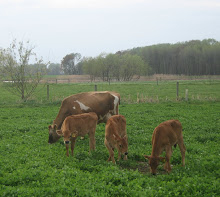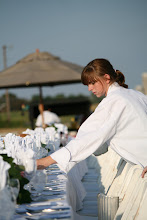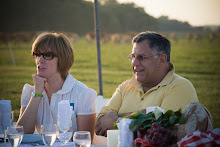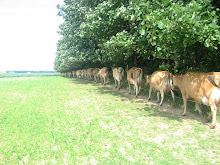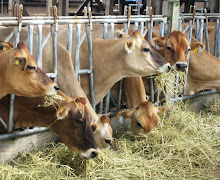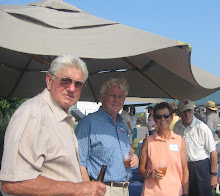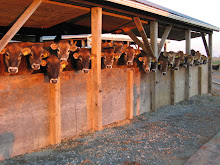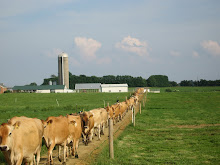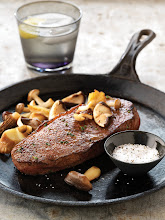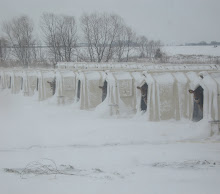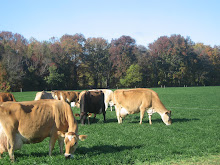This time of year is quite rewarding as we finally have ample supply of fresh and frozen beef and veal finishing off of tender spring grass. Relationships established from prior years are a nice launching pad for this season's harvest. We are fortunate to have 4 repeat customer restaurants that we sold to last year. In Chestertown, Brooks Tavern. In Royal Oak and Cambridge, Bella Luna. In Olney, Ricciuti's. and in Washington DC the Poste Moderne Brasserie.
Of particular interest to me are the unique cuts of product most often desired by some of these restaurants. Veal bones for stock, flatiron steak, sweetbreads, veal cheeks, skirt steak, liver, tongue, beef cheeks, and calf heads! OK, some of these cuts you have heard of and probably know how to prepare but for me some are very new.
Beef Cheeks are rich morsels of dense, finely grained meat. Along with veal cheeks, beef cheeks are being featured on trendy restaurant menus, especially those serving French bistro cuisine. Quite inexpensive, beef cheeks can be found either by special order or in ethnic meat markets and are usually frozen. Cheeks are always braised, and they reheat beautifully. A recipe can be linked to here and an interesting article about the DC trend for beef cheeks here.
The next new one for me was Calf Head Soup. The recipe is quite simple if you have a pot big enough. Usually the head is the main ingredient for a wonderfully flavored stock but also can be served with the soup in a large tureen. Below is a recipe, just let me know when to put your order in.
When you first get the head, have it skinned, eyes taken out, and split through the middle. Wash well, and soak several hours before cooking. Take out the brains, and tie in a bag. Boil the whole until the bones fall out; then take off the meat, skin the tongue, and chop all fine. Put in half an onion and a few sprigs of parsley, add the brains, stir all together, and put into a pudding dish. Grate over the top a few bread crumbs, add a small piece of butter, and pour over a small teacupful of the liquor the head was boiled in. Salt and pepper. Put in the oven and bake from half an hour to an hour, until brown.
The next day make calf's-head soup. Take the liquor of the calf's head, add two onions cut into pieces, one small potato, some rice or macaroni, parsley, salt, and pepper.
Sounds delicious!
Saturday, May 30, 2009
Judy, back on The Hill
 May 18 - 22, 2009
May 18 - 22, 2009
Judy Gifford shows photos of her St. Brigid's Farm near the headwaters of the Chesapeake Bay in Maryland during a Capitol Hill briefing organized by NSAC on Wednesday. Judy rotationally grazes dairy and beef cows and is an engaging champion of the Sustainable Agriculture Research and Education (SARE) program, which awarded her a grant to develop a nutrient management plan on her farm. Special thanks to NSAC member groups that supported the Hill briefing, Michael Fields Agricultural Institute and the Organic Farming Research Foundation.
Thursday, April 2, 2009
Caring for Calves

From recent posts on this blog or visits to St. Brigid's Farm you may be aware that we have been through the majority of our spring calving season. It is a busy time! Right now there are about 62 new calves that have been born since the end of January. Paul Smith is a stellar part time worker that is fully responsible for the calf care. Twice a day everyday of the month for 3 months Paul and his granddaughter, Faylyn, tend to the calves like they were their own children. Each day the calves receive 1.5 gallons of pasteurized milk and ad lib fresh water along with a 22% protein "starter" feed until they are weaned at 42 days of age. After weaning the starter feed consumption rapidly increases and by 60 days of age they will be eating 5lbs per day. By 3-4 months of age they are transitioned to a grass diet that will become the mainstay of their nutrition for years to come!
There are many different ways to raise baby calves. In our case the female calves live in a cozy hut and Paul hand delivers the milk individually to each one. For our meadow veal calves they live on a pasture with a nurse cow. In all cases the principles for success are the same. Clean, dry, well ventilated, and proper nutrition.
We thank Paul and Faylyn for the good job they are doing.
Wednesday, February 18, 2009

What in the world am I blogging about this time? Founded on Oyster Shells is the feature name for this weekend’s fund raiser in New York City for the New Amsterdam Market. For previous readers of this blog you may remember that last summer we participated in regional food market at the former site of the historic Fulton Fish Market in lower Manhattan. Click here for a glimpse of that adventure or see the July blog post.
The New Amsterdam Public Market Association is trying to preserve the market in NYC with goods supplied by vendors and farmers from the region. The New Amsterdam Market site is in constant battle with developers to change the landscape forever. Resources to develop a monthly purveyor's market dedicated to regional agriculture are certainly more difficult to find than funds for new buildings. This weekend the organizers of the New Amsterdam Market have planned a benefit dinner and auction to help sustain the market.
The New Amsterdam Public Market Association is trying to preserve the market in NYC with goods supplied by vendors and farmers from the region. The New Amsterdam Market site is in constant battle with developers to change the landscape forever. Resources to develop a monthly purveyor's market dedicated to regional agriculture are certainly more difficult to find than funds for new buildings. This weekend the organizers of the New Amsterdam Market have planned a benefit dinner and auction to help sustain the market.
We were invited to contribute to the auction and decided to participate with the donation of a St. Brigid’s Farm meadow veal calf, custom cut and processed by Haass’ Family Butcher Shop. The meadow veal is embellished by weekend stay at St. Brigid’s Farm, touring of colonial Chestertown, and lunch for two at Brooks Tavern.
The event looks like great fun and we’d love to attend but with many cows due to calve right now we’ll be close to home. For our friends nearby NYC consider the event for Saturday evening excitement. Hannah, Curt, Pepe', Maria, Kaila…? For the rest it is simply fun to peruse the event menu, donors, and donated items. For the area chefs reading this list please support the market through the on line bidding. If your not interested in the weekend stay on the farm we'll be glad to deliver the veal to your restaurant in exchange for the farm lodging!
Saturday, January 31, 2009
St. Brigid's Day, February 1st

St. Brigid - was born in A.D. 451 or 452 to a pagan father and a Christian slave mother. Her impoverished, enslaved mother did her best to raise her well, and a white red-eared cow is said to have provided all the food St. Brigid needed to grow, indicating that she was special indeed as white red-eared cows are rare in Ireland. While still a child she was put in charge of the dairy by her mother. One day she had given away so much milk and butter to poor people that none remained for the family. She feared her mother's displeasure and so resorted to prayer. When her mother visited the dairy she found such an abundance of milk and butter that she praised the dairy maids for their industry. Today she remains the patron saint of dairy maids and is the patroness of Ireland.
Amazing Instinct !
Thursday, January 22, 2009

MUCH ADO
January is the beginning of calving season. We practice seasonal breeding to align calving and peak milk production to when grass is most abundant. So we like to have most of our cows calve about 100 days before the nice spring grass is in full swing. Thus, although we are a small farm, we must be able to handle as many calvings in three months as a 500 cow operation.
To illustrate the point, January 23 is the due date for 20 heifers to have their first calf. Most likely, no heifers will calve on that date. Some will be early and some will be late. Our job is to be prepared.
This week end we got the action plan in place and prepared the maternity pens and nursery. With help from Andy Moore, a junior at the US Naval Academy in Annapolis and from a farm in NY state, (Andy’s older brother Phil, worked for us in 2002 and now flies fighter jets in the Navy), Ethan Jones, from Jones Family Farm nearby and a junior at Kent County High School, and Abelardo Perez, from Vera Cruz, Mexico and a long time helper at St. Brigid’s Farm, we transformed many of the buildings into comfortable, bedded calving pens and set up the nursery.
A few pictures are to the right and soon we’ll update you on the new arrivals!
January is the beginning of calving season. We practice seasonal breeding to align calving and peak milk production to when grass is most abundant. So we like to have most of our cows calve about 100 days before the nice spring grass is in full swing. Thus, although we are a small farm, we must be able to handle as many calvings in three months as a 500 cow operation.
To illustrate the point, January 23 is the due date for 20 heifers to have their first calf. Most likely, no heifers will calve on that date. Some will be early and some will be late. Our job is to be prepared.
This week end we got the action plan in place and prepared the maternity pens and nursery. With help from Andy Moore, a junior at the US Naval Academy in Annapolis and from a farm in NY state, (Andy’s older brother Phil, worked for us in 2002 and now flies fighter jets in the Navy), Ethan Jones, from Jones Family Farm nearby and a junior at Kent County High School, and Abelardo Perez, from Vera Cruz, Mexico and a long time helper at St. Brigid’s Farm, we transformed many of the buildings into comfortable, bedded calving pens and set up the nursery.
A few pictures are to the right and soon we’ll update you on the new arrivals!
Subscribe to:
Posts (Atom)

































































































